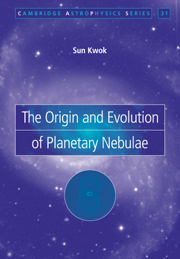Book contents
- Frontmatter
- Contents
- Preface
- 1 History and overview
- 2 Ionization structure of planetary nebulae
- 3 Nebular line radiation
- 4 Nebular continuum radiation
- 5 The neutral gas component
- 6 The dust component
- 7 Observations of the central star of planetary nebulae
- 8 Morphologies of planetary nebulae
- 9 Problems and questions
- 10 Asymptotic giant branch stars – progenitors of planetary nebulae
- 11 Evolution of the central stars
- 12 Formation of planetary nebulae
- 13 Dynamical evolution of planetary nebulae
- 14 Protoplanetary nebulae – the transition objects
- 15 Evolution to the white dwarf stage
- 16 Distances to planetary nebulae
- 17 Comparison between evolutionary models and observations
- 18 PN in the galactic context
- 19 Chemical abundances
- 20 Planetary nebulae in other galaxies
- 21 Concluding remarks
- References
- Appendix List of symbols and abbreviations
- Subject index
9 - Problems and questions
Published online by Cambridge University Press: 04 November 2009
- Frontmatter
- Contents
- Preface
- 1 History and overview
- 2 Ionization structure of planetary nebulae
- 3 Nebular line radiation
- 4 Nebular continuum radiation
- 5 The neutral gas component
- 6 The dust component
- 7 Observations of the central star of planetary nebulae
- 8 Morphologies of planetary nebulae
- 9 Problems and questions
- 10 Asymptotic giant branch stars – progenitors of planetary nebulae
- 11 Evolution of the central stars
- 12 Formation of planetary nebulae
- 13 Dynamical evolution of planetary nebulae
- 14 Protoplanetary nebulae – the transition objects
- 15 Evolution to the white dwarf stage
- 16 Distances to planetary nebulae
- 17 Comparison between evolutionary models and observations
- 18 PN in the galactic context
- 19 Chemical abundances
- 20 Planetary nebulae in other galaxies
- 21 Concluding remarks
- References
- Appendix List of symbols and abbreviations
- Subject index
Summary
By the early 1970s, the field of PN had achieved a high degree of success. The nebular spectrum in the visible was reasonably well understood and PN had served well as a laboratory for atomic physics. Laboratory or theoretically derived atomic parameters such as recombination rates, collisional excitation rates, and spontaneous decay rates had been used to interpret the observed strengths of the line fluxes. The accounting of processes not observable in the terrestrial environment (e.g. the 2γ radiation, forbidden lines, etc.) is a particularly noteworthy accomplishment. The model of PN (which we refer to as the classical model), consisting of a nebular gas shell of fixed mass photoionized by a hot central star, seemed to be adequate in explaining the nebular spectrum. The combination of sophisticated observations (in particular spectroscopy) with theoretical calculations has made physics of gaseous nebulae one of the most successful examples of modern astrophysics.
Although astronomers were justifiably elated by the success of PN research, a number of problems were lurking under the surface. Here we summarize several examples of problems with the classical model that were starting to be recognized in the early 1970s.
• The nebular mass problem: in the classical model in which the PN is made up of a uniform-density shell of a fixed mass, the ionized masses of PN should be well determined by the measurement of the Hβ flux or the radio continuum flux (see Section 4.5). However, in cases in which the distances were reasonably well known, the actual derived masses were found to spread over several orders of magnitude, in contradiction to the traditional assumption of a fixed-mass nebula.
[…]
Information
- Type
- Chapter
- Information
- The Origin and Evolution of Planetary Nebulae , pp. 101 - 102Publisher: Cambridge University PressPrint publication year: 2000
